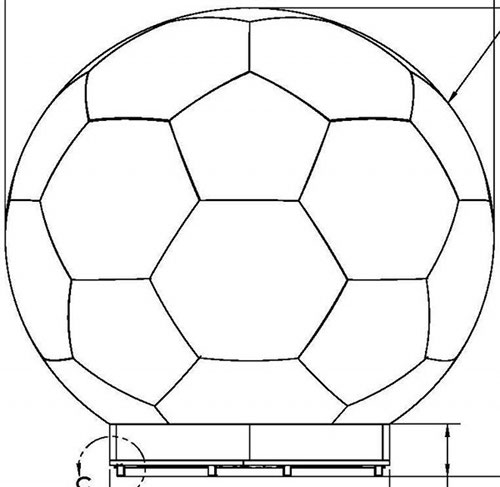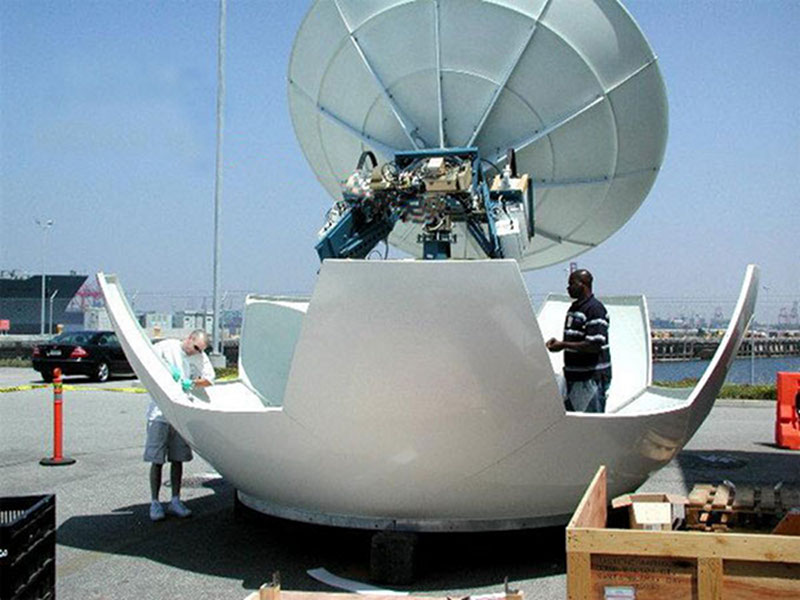
By Richard Conway, Chief Electronics Technician - NOAA Okeanos Explorer
April 13, 2012
VSAT stands for Very Small Aperture Terminal. VSATs are small Earth-based dish arrays ranging from 1.2 meters (four feet) to 3.8 meters (12.5 feet). The Okeanos Explorer dish is 3.7 meters. A VSAT is used to transmit and receive data such as video, voice, and computer information from another ground station via satellite normally in geosynchronous orbit. The stabilized antenna remains on the satellite no matter what the base beneath it does, which is very important for a ship.
The VSAT is what allows the real-time sharing of exploration data. In the past, not all scientists could go to sea. Other scientists had to wait until the ship returned to shore and copies of collected data could be made. Now with the VSAT, scientists anywhere (on ship or on shore) can participate in the exploration in near real-time.
The VSAT puts everyone watching and participating on a virtual Okeanos Explorer. Think of the ship as being a satellite, with mission control being the scientists on shore. Commands, response, returning images, sensor data, and feedback are all possible because of the VSAT.
Without VSAT, we carry 18 technical staff and four scientists. With VSAT, we carry 18 technicians and thousands of scientists, educators, students, and members of the public who just want to know more about our oceans.
Think of the VSAT as a giant Wi-Fi network. Instead of transmitting an omnidirectional (all directions) signal, the signal is concentrated and sent in a beam like a flashlight. The beam is aimed at a particular satellite on the equator. The satellite we aim at is called Intelsat 707 (IS707) and is located above the east coast of Brazil. The VSAT dish points at that satellite no matter what the ship does.
The dish receives between 3.4 to 4.2 GHz and transmits between 5.8 to 6.7 GHz. These high frequencies require special conduits for the signal to travel. In order to get the signal inside the ship through ordinary wire, the signal must be translated to a lower frequency. This is the job of the LNB (Low Noise Block). The LNB receives the high frequency signal and translates it between 950 to 1750 MHz, so it can travel down the wires to the equipment below. A unit called the BUC (Block Upconverter) takes the 950 to 150 MHz transmitted signal and translates it to the higher frequency (5.9 to 6.4 GHz) for use by the satellite.
In order to push the signal out, we use amplifiers. When you turn up your radio you are using the amplifiers to make the signal louder. The VSAT has two 400-watt power amplifiers. They can operate alone or together.

Illustration of a VSAT dome that clearly shows the dome's soccer ball shape. Image courtesy of Installation and Operation Manual for Sea Tel Model14600-75 Phase Matched C-Band TX/RX Antenna. Download image (jpg, 34 KB).
The VSAT dome, whose proper name is Radome [rey-dohm], is made out of a special fiberglass called Composite Foam Fiberglass. The fiberglass is a special composition that allows the maximum radio frequency to pass through it.
The dome on the Okeanos Explorer is a collection of 11 pentagonal and 15 hexagonal shaped fiberglass panels. These panels receive a bead of silicone caulking and then are bolted together to form the soccer ball shape. The shape of the panels give the VSAT strength. There are five more arc panels that make up the base and two regular fiberglass panels that make up the floor. The entire assembly is bolted to a steel platform that forms the mast.
The round shape of the VSAT makes it hard for the wind to push against the VSAT's surface; rather the wind flows around the VSAT's surface. If the VSAT surface was flat, the wind could push against it and collapse the structure like the big bad wolf in the story of The Three Little Pigs. Also, when we clean the VSAT, we have to make sure the protective acrylic panel coating is not scraped off, because it also protects the fiberglass.
Inside the dome are three air conditioning plants. Two are always on. The third is a booster. These units keep the temperature inside the dome between 75° and 80° F. They also remove moisture from the air. If it gets too cold, moisture starts to form on the equipment; too hot and the equipment overheats. The dome is nearly, but not entirely, airtight.

Assembly the VSAT for the Okeanos Explorer in the Fairhaven Ship Yard in Bellingham, WA, 2007. Image courtesy of Installation and Operation Manual for Sea Tel Model14600-75 Phase Matched C-Band TX/RX Antenna. Download image (jpg, 90 KB).
I do an inspection of the VSAT once or twice between cruises. When I enter the dome, I look for anything out of the ordinary, such as how the dish is sitting, moving, sounds that it makes. I look for the “does this seem right” feel. I climb on the support and look for anything broken. I look for damage or deformity to the cables and make sure bolts are not loose. I also plan for any maintenance that needs to be done at the end of the season, such as wiping down the dome surface.
The last thing I do is called a close out. The dome has two six-foot ladders inside. When not in use, these ladders lay flat on the floor; I make sure they are tied down. I also secure and make sure the containers of water and glycol (anti-freeze) in the dome for the air conditioning plant reservoir are not low. Before exiting the lower platform, I check the heat exchangers — the mechanism that air conditioning plants use to get rid of the heat. I check the fans to make sure they are working, note the ones that are not working, and may cut wires to fans that are failing.